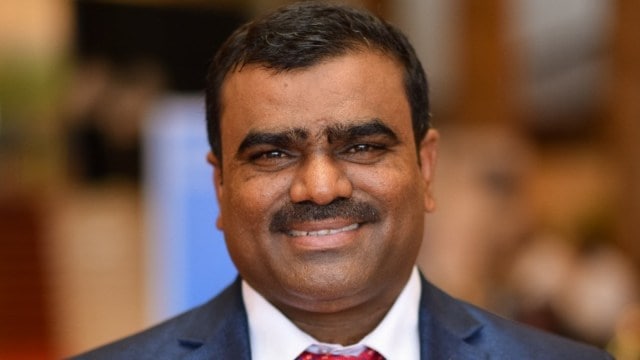Lack of access to quality education, opportunities and exposure to the competitive and financial distress to top it all impeded the growth of Sikandar Meeranaik, 40, from the Gadag district of Karnataka during his teenage years.
Courtesy to his hard work, leadership qualities and guidance from his English teacher Anil Vaidya, Meeranaik is now a successful social entrepreneur in modern day rain water harvesting, touching the lives of thousands of farmers across the country.

If one would ask him his goal about two decades ago, he would have probably pictured himself as a farmer, given the rich agricultural background he comes from. However, cut to 2024, Meeranaiak now wants to recharge 10,000 borewells across India through his cost-effective rainwater harvesting solution, in regions with water scarcity by 2030.
Story continues below this ad
Meeranaik is the CEO of Sankalpa Rural Development Society, a non-profit organisation in Hubbali dedicated to providing water for farmers affected by the falling water table and poor monsoon rain. The organisation aims to end water scarcity in India using an integrated rural development approach to create awareness of the imperative need for rain water harvesting for farmers and communities, especially in the parched regions.
The organisation implements various modern yet cost-effective ways of rain water harvesting solutions such as borewell recharge, rooftop water harvesting and pond restoration. In addition, Sankalpa Rural Development Society also works towards women empowerment through self-help groups, education on financial literacy, and better living.
Speaking to The Indian Express, Meeranaik recalls the beginning of his journey with a story of failure.
“I did not pass my SSLC (Class 10) exam. I was not fluent in English and hence I couldn’t pass the subject. But I did not give up. My English teacher thought I had the potential to perform well and also understood that I possessed good leadership skills that would come handy in future. I asked him to help me in English only to an extent where I can score the passing marks and complete SSLC. That is what transpired and I passed my SSLC in the supplementary examination,” said Meeranaik.
Story continues below this ad
Vaidya also guided Meeranaik to pursue Bachelors in Social Work, given his passion for social work, oratory and leadership skills.
While pursuing his education, Meeranaik got engaged in his first major project through the Karnataka government’s Kuligagi Kalu scheme which offered food grains to people who supported the government in developmental work.
“Coming from a parched region like Gadag, I understood the importance of water and how inaccessibility to waterbodies can crush the agrarian sector. Through this programme I focused primarily on helping the government in building lake bunds, restoring lakes, recharging borewells, following which I was given food grains by the government,” said Meeranaik.
Just when Meeranaik found his calling, his passion towards solving the water crisis took a new shape, when he landed a fellowship programme with the famous Deshpande Foundation in Hubballi in 2008.
Story continues below this ad
This was a big turning point for Meeranaik, as he studied skill development there for six months learning English, computer applications, among other skills. This education helped him to start his own enterprise – Sankalpa Rural Development Society.
“I owe my success as a social entrepreneur to the former CEO of the foundation Naveen Jha. I felt very inferior after I realised that I was surrounded by good English speaking candidates in the programme. In fact, for the first time in my life I had actually touched a laptop. However, he (Jha) was there to hand hold me and guide me throughout the programme,” said Meeranaik.
Meeranaik received a grant of Rs 50,000 at the completion of the fellowship programme and the task at hand was to utilise the funds to get the organisation running.
His first project was to recharge seven borewells of a government primary school in Hubballi. Following which he landed a Rs 10 lakh-worth borewell research project of agricultural lands around Hubballi where he recharged over 25 borewells.
Story continues below this ad
“I use the Twin Ring Method to recharge borewells which is modern, cost effective and brings back water in dried up borewells. So far we have recharged around 2,800 borewells across 10 states, including Tamil Nadu, Andhra Pradesh, Maharashtra, Kerala, and Madhya Pradesh, among others,” says Meeranaik.
In addition, Meeranaik is also closely working with SBI Foundation to help reach medical services in remote areas in select five villages of Gadag district.
In addition, he is also conducting remedial classes in sciences, mathematics, social science for students of government schools in these villages.
“Interestingly, the SBI foundation gifted us a JCB in recognition to our efforts. We are now renting out this JCB for farmers in Gadag district for a nominal fee to help them carry out agricultural work in connection with water needs like bunding, pond creation among others,” said Meeranaik.
Story continues below this ad
Further, in Gadag and Dharwad areas, Meeranaik’s organisation is working with approximately 5,600 women in 700 self-help groups. The organisation offers microfinance loans to these women to support small entrepreneurs in their business needs. Through these loans the women are financially empowered to set up enterprises such as kirana stores, and purchase livestock such as cows or buffalo for milk production, sewing machines to set up tailoring business, among others.
What is Twin Ring Method?
A pond of size 20x15x8 is constructed near the borewell site to collect monsoonal runoff. Using a JCB, a 6x4x8 feet pit around the borewell casing is lined with filtration material. Slits are cut into the casing, wrapped with nylon mesh, and surrounded by two sets of 6×3 feet cement rings. The first set, filled with 20mm stones, forms a “false well,” while the second one, left empty, is sealed and covered. A 3-inch feeder pipe from the pond connects to the first cement ring of the empty well. During the rainy season, water from the pond percolates through the first well, entering the aquifer through casing slits for dry season storage.









